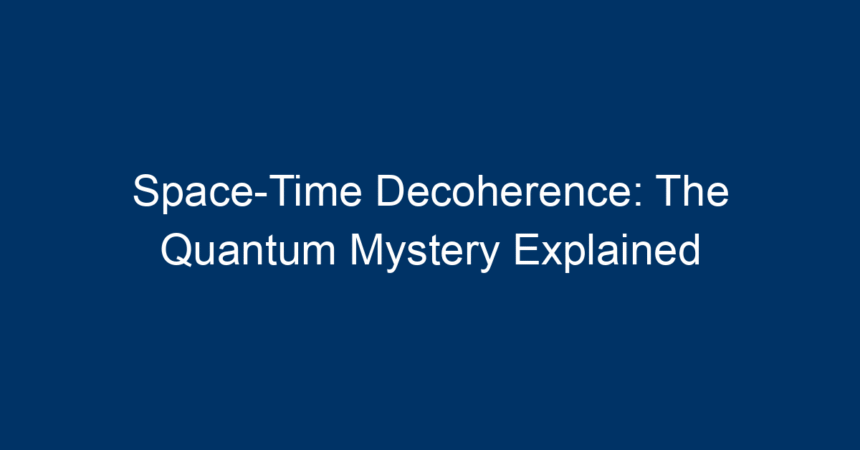Introduction
In the realm of quantum mechanics, space-time decoherence emerges as a fascinating yet perplexing phenomenon. It bridges the gap between the microscopic quantum world and the macroscopic classical world we experience daily. Understanding space-time decoherence not only sheds light on the strange behavior of particles but also challenges our perceptions of reality itself. This article delves into the intricacies of space-time decoherence, exploring its implications in quantum physics, its role in our understanding of the universe, and the exciting potential it holds for future technological advancements.
What is Decoherence?
Decoherence is a quantum mechanical process through which a system loses its quantum coherence, leading to the emergence of classical properties. In simpler terms, it’s the transition from a superposition of states—a hallmark of quantum systems—into a definitive state that conforms to classical physics. This transition can be observed when a quantum system interacts with its environment, resulting in the loss of information characterizing its quantum state.
The Quantum Superposition Principle
To fully grasp decoherence, we must first understand quantum superposition. Quantum systems, such as electrons or photons, can exist in multiple states simultaneously. For instance, an electron can be in multiple locations at once until measured. This phenomenon is vividly illustrated through Schrödinger’s cat thought experiment, where a cat can be alive and dead until observed.
Decoherence disrupts this superposition, forcing the system into a specific state. This change is critical in reconciling quantum mechanics with classical observations, creating a bridge between the two realms.
Space-Time Decoherence: An Overview
Space-time decoherence refers specifically to how quantum systems behave within the fabric of spacetime. It posits that the fundamental interactions that lead to decoherence are not only a matter of time but also of spatial configurations. A more profound understanding of space-time decoherence opens up new avenues in theoretical physics, potentially resolving some of the deepest questions about the universe.
Why is Space-Time Decoherence Important?
-
Classical Observation: Space-time decoherence explains why macroscopic objects do not exhibit quantum behavior. While individual particles can behave strangely, the collective behavior of many particles tends to align with classical physics, as decoherence effectively "classicalizes" the system.
-
Quantum Measurement Problem: The measurement problem in quantum mechanics concerns how and why quantum systems collapse into a definite state upon observation. Space-time decoherence offers insight into this problem, suggesting that interactions with the environment lead to apparent wave function collapse without needing an observer.
- Quantum Computing: As we move toward quantum computing, understanding space-time decoherence becomes increasingly vital. Quantum computers leverage superposition for calculations, but decoherence can disrupt these states, potentially leading to errors. Mitigating decoherence is essential for developing stable quantum systems.
The Mechanisms of Decoherence
Understanding space-time decoherence involves delving into its mechanisms. The decoherence process is primarily driven by the interactions between a quantum system and its environment, which can include anything from cosmic background radiation to nearby particles.
Environmental Interactions
When a quantum system interacts with its surroundings, it becomes entangled with them. For example, if a quantum particle interacts with the atoms in a wall, the coherence of its wave function becomes fragile. This interaction results in the loss of quantum information, leading to classical behavior.
Role of Temperature
Temperature also plays a significant role in decoherence. Higher temperatures lead to increased particle motion and interactions, accelerating the decoherence process. In quantum systems, understanding how temperature influences coherence can help scientists design experiments and technologies that minimize decoherence effects.
Implications of Space-Time Decoherence
The implications of space-time decoherence resonate across various fields, from physics to philosophy. Here are some key domains where its impact is notably profound:
Quantum Gravity
Space-time decoherence has the potential to inform theories of quantum gravity, helping to unify quantum mechanics and general relativity. By understanding how quantum systems behave within the fabric of spacetime, scientists can develop models that address the fundamental forces of nature and the beginnings of the cosmos.
Cosmology
Decoherence may also offer perspectives on cosmic events such as the Big Bang. By examining how quantum fluctuations during the early universe might have influenced its evolution, researchers can gain insights into the origins of structure in the universe.
Philosophical Considerations
Space-time decoherence raises interesting philosophical questions about reality, observation, and existence. It challenges our understanding of determinism and the role of the observer in defining reality. The implications of these concepts stretch beyond science and into the realm of consciousness and existence.
The Future of Space-Time Decoherence Research
As the scientific community continues to explore the nuances of space-time decoherence, several avenues of research are emerging:
-
Experimental Verification: As with many aspects of quantum theory, experimental verification is essential. Researchers are developing new technologies to test the effects of decoherence in real-world systems, paving the way for breakthroughs in quantum physics.
-
Applications in Quantum Technology: Understanding and controlling decoherence is critical for improving quantum technologies, from computing to communication. Innovations in error correction and fault tolerance will be key to realizing the full potential of quantum capabilities.
- Interdisciplinary Studies: The complexity of space-time decoherence encourages collaboration across disciplines. Physicists, philosophers, and cognitive scientists are increasingly working together to explore the implications of decoherence on our understanding of reality.
Actionable Insights: Navigating the Quantum World
To better understand and appreciate space-time decoherence, consider the following actionable insights:
-
Stay Informed: Engage with current research on quantum mechanics, decoherence, and their implications. Journals, podcasts, and online courses offer various resources for learning.
-
Explore Quantum Technologies: Keep an eye on advancements in quantum computing and technology. Understanding these innovations assists in grasping the practical applications of decoherence.
- Embrace the Mystery: Approach the quantum world with curiosity. Space-time decoherence challenges conventional wisdom and invites contemplation about our understanding of the universe.
Conclusion
Space-time decoherence is a profound phenomenon that bridges the quantum and classical worlds, reshaping our understanding of reality. By unraveling the mysteries of how quantum systems interact with their environments, we can gain insights that influence everything from fundamental physics to cutting-edge technologies. As research continues to unravel the complexities of space-time decoherence, the journey promises to be as intriguing as the quantum world itself. Embracing this quantum mystery is not only essential for scientists but also for anyone curious about the fabric of our universe.




